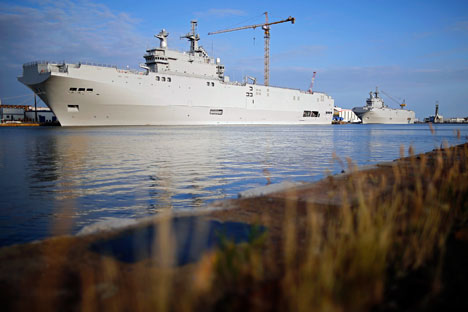No ‘mistrals’, no problem for Russia

Two Mistral-class helicopter carriers Sevastopol (L) and Vladivostok are seen at the STX Les Chantiers de l'Atlantique shipyard site in Saint-Nazaire, western France, May 21, 2015.
ReutersThe sale of ‘Mistral’ naval vessels to Russia has finally been scrapped, with the French government deciding to repay Moscow for its decision to not deliver the helicopter carriers. There is a saying in Russia that fits the occasion: “Whatever happens, happens for the best.”
Russian officials first thought of purchasing the ships in 2008. This was largely a politically motivated deal; Russian - French ties were on the upswing with French President Nicolas Sarkozy not only playing a crucial part in resolving Russia’s conflict with Georgia, but also helping to minimize its impact on relations between Russia and the West in general.
While Russia’s former President Dmitry Medvedev supported the deal, Vladimir Putin, who was then prime minister, was never in favour of the deal. As Putin revealed two years ago, “We signed these contracts primarily to support our partners and offer some work to their shipyards. Frankly speaking, it is of little consequence for us or our defence capability.”
Doomed from the start
Indeed, the French warships were destined to become “outcasts” within the Russian navy from the beginning. Had the sale gone through, Russia would have become reliant on foreign replacements, which would probably not comply with Russian standards. This could have been tackled if relations with the supplier were good. But in the aftermath of the Ukraine crisis and sanctions being imposed, the situation would have been grim.
Then, some serious doubts were raised about whether the navy actually had any need for these expensive “toys.”
The ‘Mistral’-class vessels are versatile: They can serve both as flagships and as command and control centres during naval combat. In fact, among the reasons to go for the purchase was to obtain some insights into modern naval combat techniques used by Western countries.
However, the main purpose of the Mistral ships is to land and support ground forces on enemy territory while remaining far from the shore. The problem is that Russia does not stage such operations; they are not even mentioned in the country’s naval doctrine. The only thing Moscow could use these ships for would be to land a force in Syria to help President Bashar al-Assad’s regime and, maybe, fighting pirates off the coast of Somalia.
But would those missions have really justified such expenses?
A square peg in a round hole
In fact, the Mistral ships did not fit into the traditional strategy for the deployment of Russian naval infantry troops. To elaborate, unlike Russia’s amphibious warfare ships (which, admittedly, are obsolete and in need of modernization), Mistral ships cannot approach beaches.
Moreover, they need supplementary equipment to be able to land heavy vehicles, not to mention the fact that they are not capable of carrying a great number of such vehicles in the first place. The deployment of this equipment takes time, and in the interim each vessel needs to be protected by a group of escort ships – which, given the standard strategy for amphibious warfare described above, are not at all numerous within the Russian navy.
In turn, the military hardware used by Russia for amphibious operations was unsuitable for the Mistral ships for a number of reasons. For instance, the Ka-52 and Ka-27 helicopters that the ships were supposed to carry were too big to fit through the doorway of the helicopter hangar elevator. What is more, the fuel these helicopters use is far more flammable than the standard NATO fuel, which is critical, considering the vulnerability of Mistral vessels.
These technical issues and inconsistencies were numerous, so the ships would probably have needed to be modified further once delivered to Russia — while it was doubtful they would see any use at all.
But the really crucial part — that was revealed even before the sanctions [over Moscow’s role in the Ukrainian crisis – RBTH] were imposed on Russia — was that France, under intense pressure from its NATO allies, refused to sell the ships equipped with traditional NATO hardware, namely the SENIT 9 information processing system and the advanced SIC-21 command and control system. Thus, the one strong argument in favor of buying the French “toys” was no longer valid.
If the vessels had eventually been sold to Russia, they would have probably seen very limited use, most likely as transport ships capable of carrying out rescue operations in a relatively peaceful environment.
It should also be noted that France only built two Mistral-class ships for its navy, and all previous attempts by the French government to sell them to other parties have failed. If not for Russia, the shipyard in Saint-Nazaire – which constructs the vessels could have gone out of business.
A Russian answer to the problem?
Still, the Russian navy really does need a new generation multipurpose amphibious warfare ship. Such a vessel will most likely be developed by Russia itself, based on the existing Priboi project – which means it will be equipped with Russian-made systems and components that will comply with Russian standards.
The first ship of the new class will be launched in 2020. While Priboi-class vessels will be somewhat slower than the Mistral ships and have 20 percent shorter range, they are in many ways superior: They will have a larger draft, will be able carry more supplies and will hold 30 helicopters, compared to eight for the French ships.
It is still a pity the country wasted seven years on the Mistral deal. But, to recap, “anything that happens, happens for the best.” Or rather, better late than never.
The author is a political scientist and a member of the Foreign and Defense Policy Council.
All rights reserved by Rossiyskaya Gazeta.
Subscribe
to our newsletter!
Get the week's best stories straight to your inbox